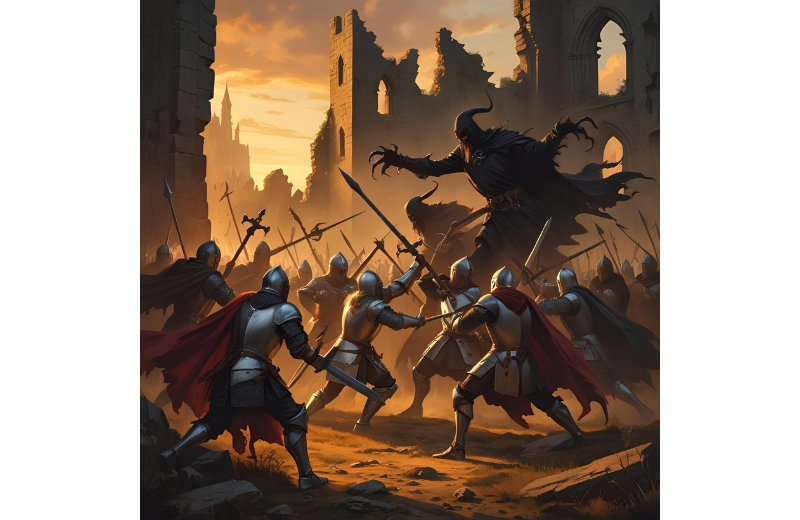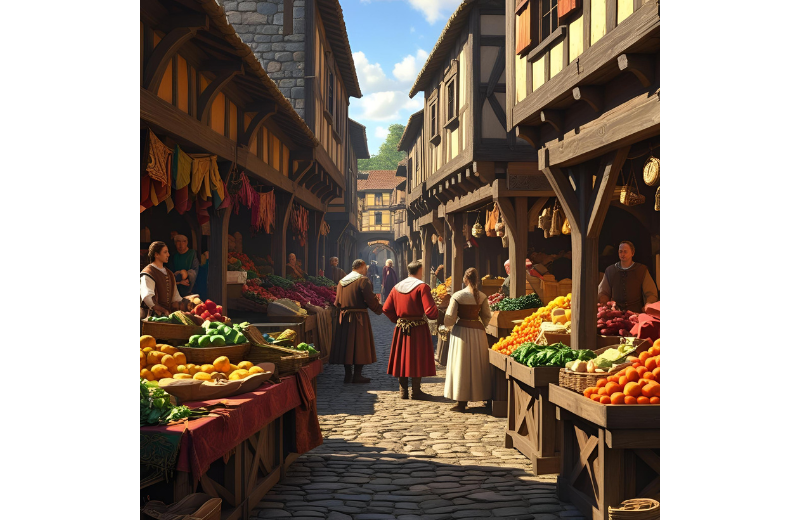Have you ever picked up a book and felt completely lost in its world, as if you could walk down its streets, smell its forests, and talk to its characters? That feeling doesn’t happen by accident. It’s called world-building, and it’s one of the best ways to draw readers deep into your story.
This blog post offers 12 simple yet powerful tips for world-building, which you can apply to your own creative writing projects.
Jump to:
Recommended for you!
Best SellersWhat is World Building?
World‑building is the art of creating a believable and captivating setting for your story. It’s about shaping its landscapes, history, cultures, and characters so that readers can step inside and imagine themselves there. In short, it’s how you bring a fictional world to life.
Good world-building is about making your readers believe that this place could really exist. Think of Hogwarts from Harry Potter, Middle Earth from The Lord of the Rings, or Arrakis from Dune. These are places that feel lived in, rich in history and detail.
What Are the Two Types of World Building?

There are two approaches to world-building, and they both have their strengths. The one you choose depends on the kind of story you’re telling and the experience you want to create for your readers.
- Soft World Building: Provides enough detail for readers to imagine the rest. The world serves the story and its characters, allowing room for readers to fill in the spaces with their own ideas.
Example: Harry Potter is an example of soft world-building. Its magic and settings are introduced gradually, focusing more on character and plot than on an elaborate explanation of every rule and mechanism.
- Hard World Building: Goes deep into every facet of the world, its physics, politics, economies, and histories. This approach creates an intricate, fully realised setting where every piece feels thought‑out and connected.
Example: Dune is a classic example of hard world-building. Its pages are packed with details about climate, politics, religion, and language.
Why World Building Matters in Every Genre
World‑building isn’t only for fantasy or sci‑fi writers; it’s an important part of every genre. Even if your story is set in a small town or a single room, you’re still creating a “world” for your readers.
A gripping crime thriller needs a believable city with its own rules, tensions, and atmosphere. A historical romance must capture the sights, sounds, and customs of its era. Even contemporary stories benefit from a strong sense of place and context.
World-building is what gives a story its richness and depth, allowing readers to step inside and connect with it, no matter the genre.
World Building Tips in Writing
1. Start Simple

It can be tempting to dive into every tiny detail when creating your own world, but it’s better to start simple. Begin with a scene, character, or setting that excites you and build out from there, adding details gradually until you have a strong framework.
For example:
- Begin with a single city or village that sparks your imagination.
- Decide how its people live, work, and play, and why these things matter to them.
- Let this lead you to exploring the lands beyond its borders, expanding your world piece by piece.
2. Read Widely and Observe the Real World
Even when creating a completely fictional setting, it can be inspired by the richness of the world we live in. Read about different cultures, explore myths and histories, or observe how communities interact with their environments.
The more you notice, the more ideas you’ll have for building a compelling, authentic world. By combining these observations with your imagination, you can create a setting that feels both captivating and believable.
3. Follow the 4 Cs

The 4 Cs are a helpful way to think about world-building. You can use this as a checklist: for every scene you write, ask yourself if it reflects the culture, character, conflict, or context of your world.
Culture
Consider the traditions, holidays, and social norms that shape everyday life in your world. Do people have festivals for special occasions? What customs do families follow? How do people greet each other? For example, in a fantasy realm, a “Harvest Day” festival might unite villages every autumn, or a strict code of honour might govern how warriors behave. These details help your world feel lived-in and distinctive.
Character
Think about how your characters fit within the world you’ve created. Do their roles, jobs, or ways of thinking arise naturally from their surroundings? A character growing up in a bustling desert city will have very different habits, language, and priorities than someone raised in a remote mountain village. Let the world shape the character, and in turn, let the character reveal more about the world.
Conflict
What tensions arise from the differences within your world? Perhaps one kingdom hoards resources while another struggles, leading to rivalry or rebellion. Or maybe ancient prejudices between species create mistrust. Conflict doesn’t have to be limited to battles; it can be rooted in culture, belief, or environment. The struggles you create will drive the story forward and deepen readers’ understanding of the world.
Context
Give your world a sense of history. What came before? What events shaped its politics, borders, or traditions? Even if you don’t share every detail with the reader, knowing this background can guide how you write. Perhaps the ruins of an old castle hint at a long-vanished kingdom, or old songs tell of a legendary hero. These touches give depth and richness to your setting.
4. Focus on The 3 Pillars
Another approach to building a world is focusing on three core areas: geography, people, and history.
Geography
What is the landscape like? What environments dominate your world? The geography you create doesn’t just set the scene; it can also shape how people live, what resources they have, and how they move from one place to another. For example, a kingdom surrounded by mountains might be isolated, making its people wary of outsiders, while a city by the sea might have a long tradition of exploration and trade.
People
What civilisations or species inhabit your world? Are they nomadic or settled? What are their ways of life, their habits, rituals, and daily routines? Consider how the environment affects them. Perhaps a society that lives in a desert has developed ways to conserve water and knows how to read the stars, or a mountain clan has learned to hunt and build with stone. By focusing on people, you breathe life into the landscapes you’ve created.
History
This is similar to the “Context” we talked about in the 4 Cs. Both ideas focus on making sure your world has a sense of heritage, where its traditions, tensions, and secrets have roots in its past. Knowing the history of your world gives depth to its landscapes and communities, allowing you to drop hints and create moments where the past and present connect.
5. Stay Consistent

The golden rule of world-building is consistency. Whatever rules you set for your world must be followed throughout your story. If magic has limitations, stick to them. If a city doesn’t have access to certain resources, this should affect its culture and politics. This makes your world feel authentic and believable.
6. Incorporate Symbols and Beliefs
Give your world depth by creating its own symbols, spiritual beliefs, or superstitions. What gods or deities do its people pray to? What signs or rituals mark moments of change? Even small details, like a flower that symbolises remembrance or a special gesture of respect, can make your world feel rich and memorable. These symbolic elements help ground your setting and give readers a deeper sense of its culture and its people.
7. Let the World Evolve with the Story
Allow your setting to change as events unfold. Cities can rise or fall, borders can shift, and environments can be altered by character choices or conflict. Perhaps a long‑standing peace is broken by war, reshaping alliances and boundaries. Maybe a harsh winter forces characters to adapt, or a volcanic eruption changes the landscape forever.
By letting your world evolve and respond to the events of your story, you create a dynamic, breathing setting that feels truly alive. This approach doesn’t just deepen the reader’s connection to the world; it gives a sense of progress and belonging, making every change a meaningful part of the narrative.
8. Show, Don’t Just Tell
Let your world come alive through moments and details. Rather than stopping to describe every fact about your setting, show it in action. Let readers experience the sights, sounds, and smells of your world through the eyes of your characters.
For example, if your world has strict laws, you can show this through a scene at a bustling market or an argument between two friends. By focusing on how the world affects its characters, you invite readers to experience it naturally.
9. Use Sensory Details

Make your world come alive by describing sights, sounds, smells, textures, and tastes. The more vivid the sensory experience, the more real it will feel to your readers. Think about how a bustling marketplace might hum with voices, the warm smell of freshly baked bread drifting from a bakery, or the sting of icy wind brushing a character’s skin.
These small moments can have a big impact, pulling readers deeper into your story and making them feel as if they’re standing right beside your characters. By focusing on sensory details, you give your world depth and richness, making it truly memorable.
10. Test Your World Through the Characters
Try exploring your world through the lens of a character. What do they notice when entering a new city? By seeing your world through a character’s eyes, you can spot inconsistencies, discover new details, and create a setting that feels lived‑in and authentic. It’s one of the best ways to ensure your world doesn’t just exist in the background, but actively shapes and influences the story.
11. Build Through Dialogue and Action

Use character interactions to reveal your world. Have your characters speak, argue, joke, and react in ways that reflect the culture and rules of the world. Let a conversation about a banned book or a character’s reaction to a traditional festival reveal more about the setting than a long description ever could. This approach keeps readers engaged and allows the world to deepen naturally.
12. Balance Detail with Storytelling
Give enough information for readers to understand your world, but don’t overwhelm them with too much at once. The best details are those that deepen character motivations, highlight a key theme, or move the plot forward. Instead of stopping to explain every custom or piece of history, weave these moments naturally into the scene through character interactions, observations, or moments of action.
Recommended for you!
Best SellersStudy Our Novel Writing Diploma for £29
Now that you’ve discovered the secrets of world‑building, why not put them into practice and create a captivating world of your own? Our Novel Writing Diploma Course at the Centre of Excellence is the perfect next step. The course is designed for writers of all levels and covers every stage of writing a novel, from initial idea to final polish. For a limited time, you can enrol for a discounted price of £29!













